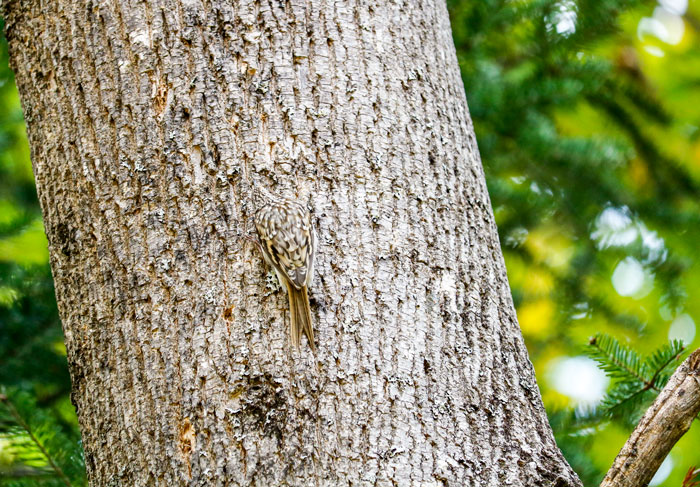
Although the brown creeper isn’t the easiest bird to spot while one is watching birds out in the woods, with some observation, their behavior can be described as being quite predictable in a sense. Being that these tiny woodland birds have a fondness for the biggest trees they can find, you can often find them spiraling up the base of a tree to the very top of one tree and then fluttering down to the base of another to begin spiraling up again. While they climb up the trunks of trees, they probe into crevices, looking for insects and insect eggs with their downcurved beaks. It is simply fascinating while against the bark of a tree, how well these birds are extremely well camouflaged, obscuring their presence from predators as they forage for food sources in a solitary fashion.
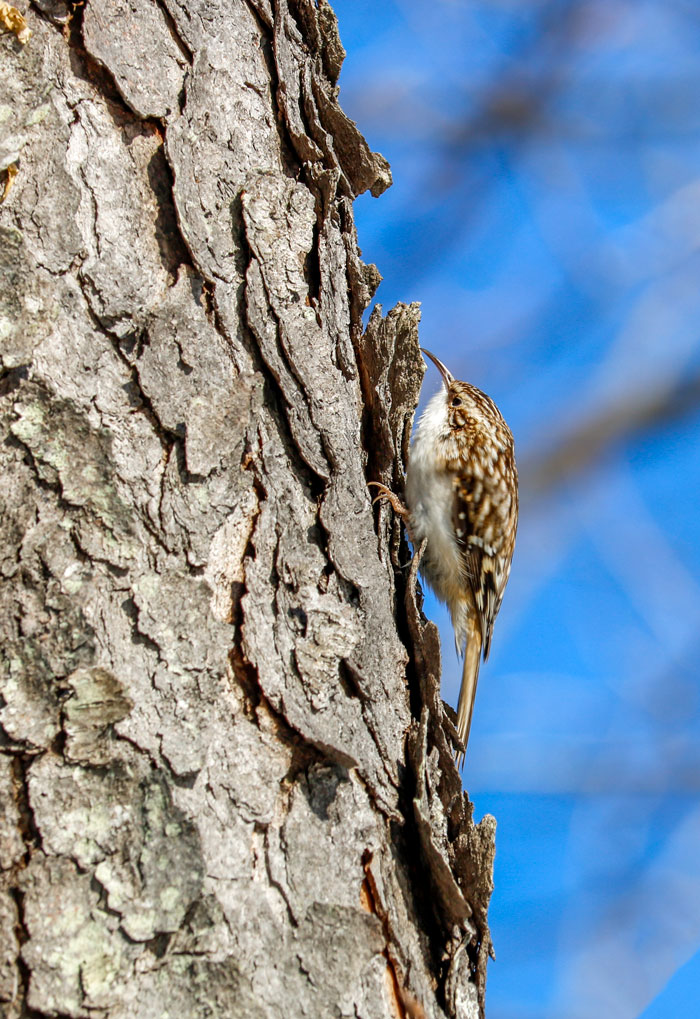
While out in the woods on the property, even though these little birds can be extremely difficult to see, I do in fact often see them before I can hear them. I have been watching them frequently this past fall and winter as they have often had similar daily feeding patterns. I found that during the morning hours, they can be found deep in the woods and then later in the afternoon, they will feed on the trees closer to the edge of the woods of the backyard. As of late, I can say with the beginning of spring, I have definitely been hearing them before seeing them. The males have been singing extremely loudly in order to attract potential mates, replacing their usual softer calls.
I am quite pleased to have discovered this somewhat secretive bird here in our forest. The following photographs are a collection that I have taken over these past months. They are not the easiest of birds to photograph with all of those quick movements around the trees, nonetheless, I hope you enjoy the following photographs and information on this fascinating bird.
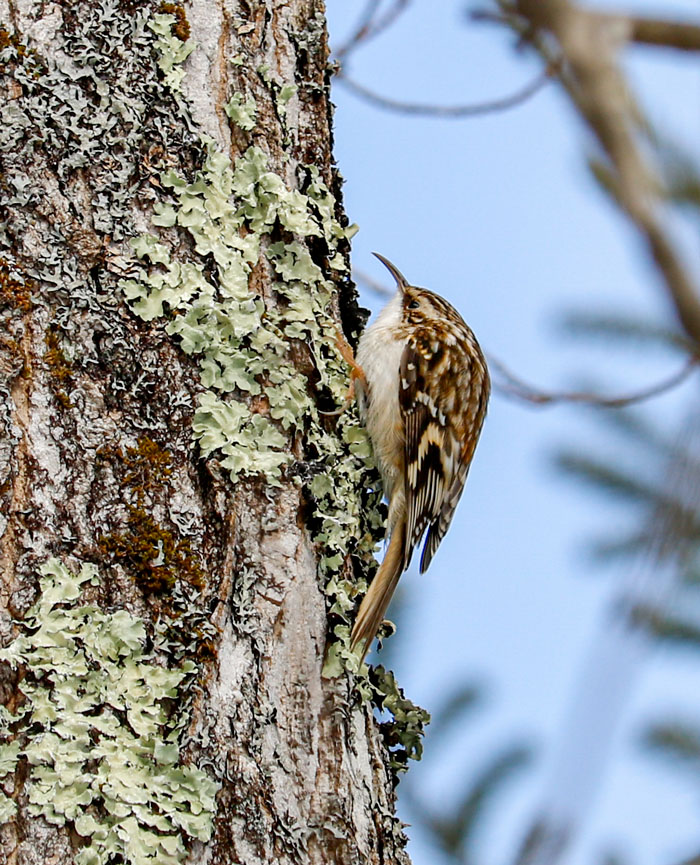
Range
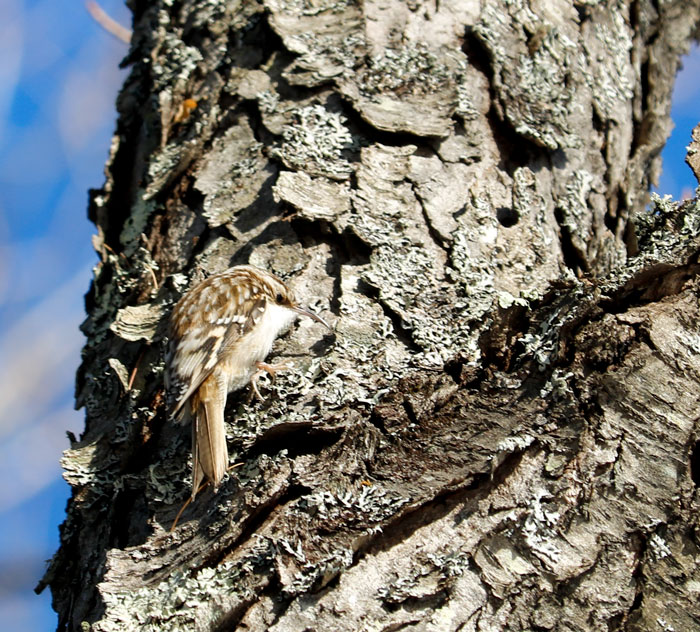
Brown creepers Certhia americana are the only treecreepers in North America. These birds are resident to short-distance migrants. They may migrate in small flocks. In many areas, migration will peak in April and in late September to early October. They are found throughout North America from Canada and Alaska to as far south as northern Nicaragua. Over most of their breeding range, brown creepers do not migrate, although northern and high-altitude populations move south or downhill in winter. In the western United States, they can be found throughout forested areas of the Rocky Mountains in western Washington, Oregon, and the northern mountains of California. In Alaska and Canada, brown creepers generally breed along the coast. In British Columbia, brown creepers breed along the western coast and through the central and southern interior.
Description
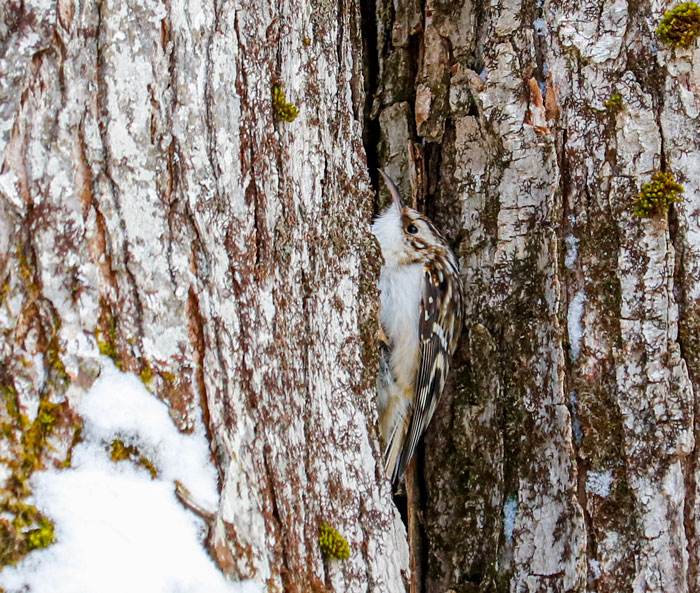
Brown creepers are tiny songbirds with mottled feathers that make them nearly indistinguishable from a piece of bark when viewed from a distance. They have slim bodies with long-spine-tipped tails and slender, decurved bills. Coloring includes a streaked brown and buff above, with their white underparts usually hidden against the trunk of a tree. Their brownish-in-color heads display a broad, buffy stripe over the eye.
Habitat
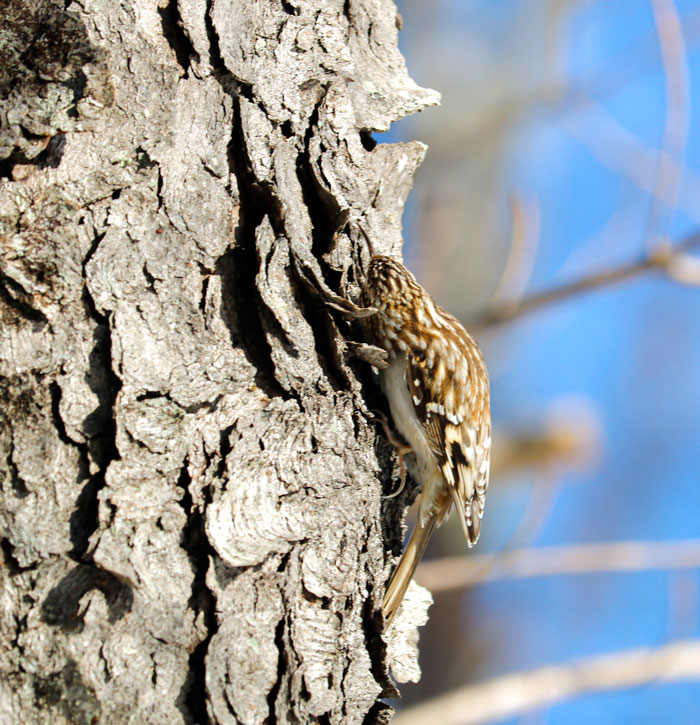
Brown creepers prefer to forage and breed primarily in mature evergreen or mixed evergreen-deciduous forests with (dead or alive) large trees. During the winter season, these birds move into a broader variety of forests and become much easier to find in deciduous woodlands.
Behavior
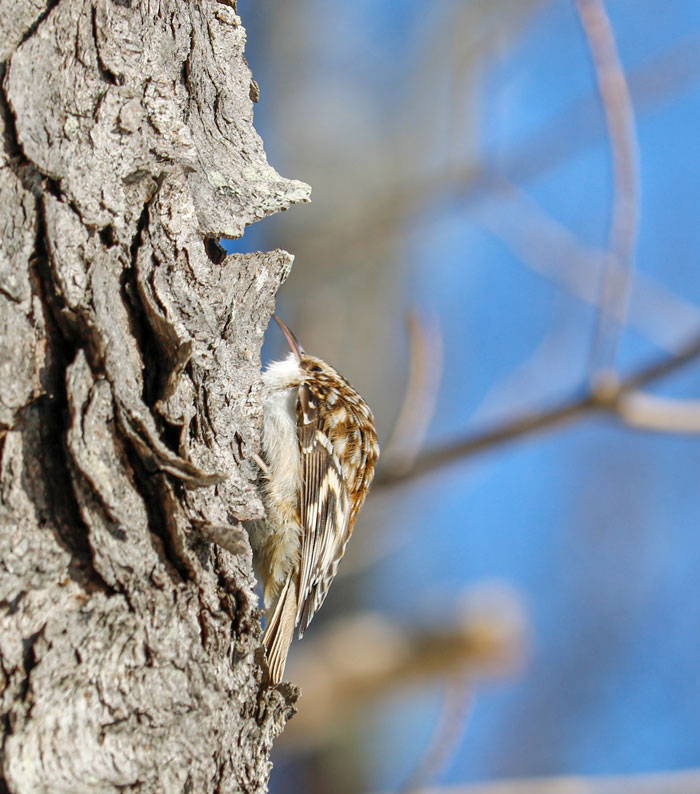
Brown creepers search for small insects and spiders by hitching upward in a spiral around tree trunks and limbs. They move with short, jerky motions using their stiff tails for support. To move on to a new tree, they fly weakly to its base and then resume climbing up toward the top.
Diet
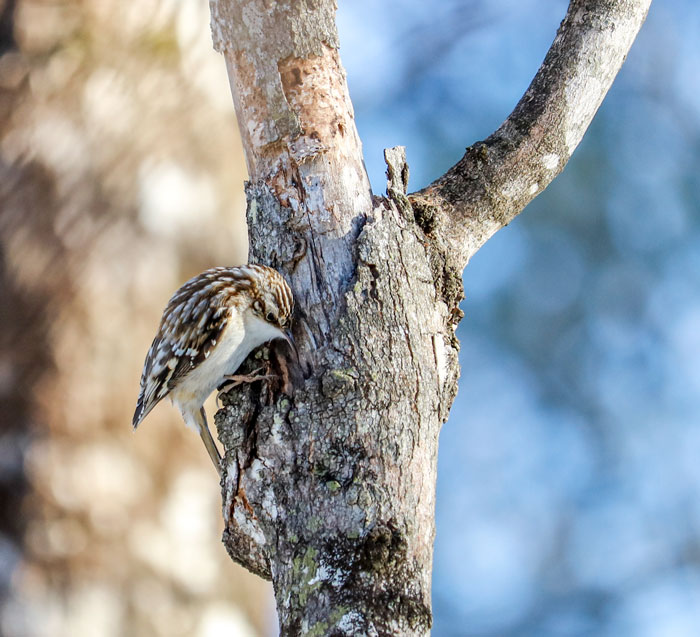
The diet of the brown creeper mostly consists of insects. These birds feed on a wide variety of insects, especially insect eggs and pupae hidden in the bark; also weevils and other beetles, true bugs, leafhoppers, scale insects, aphids, caterpillars, ants, and many others. They also feed on spiders and pseudoscorpions and will also feed on some seeds, as well as suet or peanut butter mixtures.
Call & Song
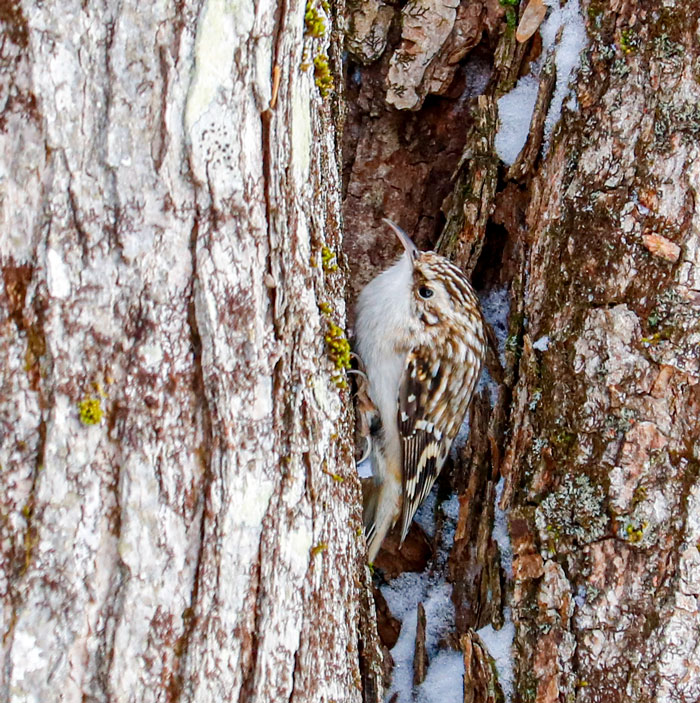
Both the males and females make high, wavering call notes that sound like a small chain being dropped into a heap; these notes are noticeably longer than the very short call notes of several other birds. Creepers give these calls all year long especially while foraging. They use other variations of calls during flight, courtship chases, courtship feeding rituals, and aggressive interactions. Their calls can be difficult to distinguish from the calls of the golden-crowned kinglet. Recently while out in the woods, I have had a bit of difficulty with this myself. The golden-crowned kinglets have just arrived a few weeks ago and the male brown creepers have just started becoming more vocal just around the same time. I suppose as the season progresses, I’ll get to know who is who, hopefully from both, sight and sound.
Only the male sings, and usually, only on breeding grounds, although sometimes during migration as well. His song is a jumble of high, thin notes that lasts up to one and a half seconds. It’s sometimes likened to singing the phrase trees, beautiful trees. Brown creepers may join single songs together two or three times in a row. Although the delicate song carries well through the woods the thin, high notes can be easily missed.
Reproduction & Nesting
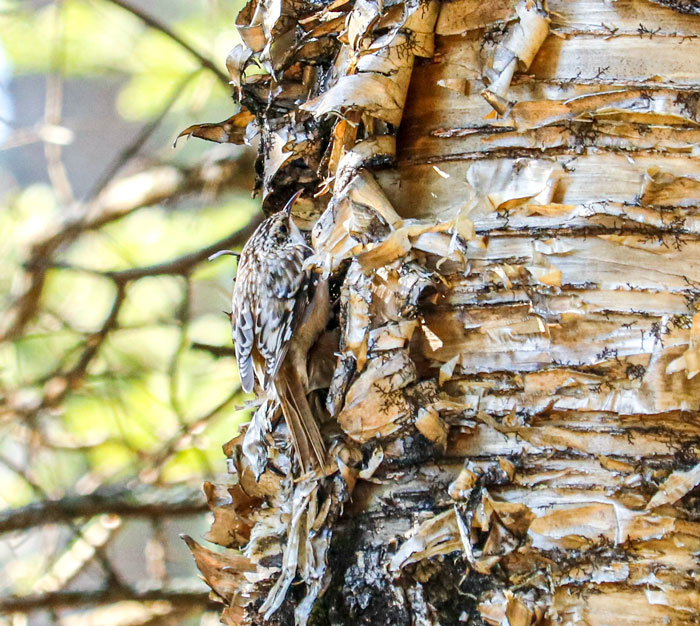
Brown creepers are monogamous. As discussed previously, males will sing to attract a mate. The pair then chases one another, rapidly fluttering their wings and exposing their white undersides. Nesting sights are usually constructed behind a large strip of bark still attached to a tree; occasionally in a cavity in a tree. They may be at any height from very low to fifty feet or more above ground. Nests are occasionally found in other locations such as inside a stack of concrete blocks and under loosened roof shingles. In typical sites, the nest is a shallow half-cup, closely fitting the available space behind the bark slab. The male and female choose the nest site together and the nests are built by females, with males bringing some material that is made of twigs, bark strips, moss, and leaves, lined with finer materials.
In the photograph above, I observed this brown creeper gathering bark from this yellow birch for its nest.
Males feed the females throughout the nesting cycle until the eggs have hatched. There are five to six eggs, sometimes four to eight. The eggs are whitish, dotted with a reddish-brown. Incubation is done by females, for about fourteen to seventeen days. Males may feed females during incubation. Both parents bring food for nestlings. Breeding pairs remain together for up to several weeks after their young are ready to fly. Young leave the nest about thirteen to sixteen days after hatching.
How to Attract the Brown Creeper
You are more likely to attract brown creepers if there are large, old trees in close proximity to your residence. If you don’t live in this type of environment, these birds can be observed and enjoyed out in nature as well, as you will most likely find them along nature trails or while hiking in the woods.
Although insects are an idyllic food source for the brown creeper, during the winter, if provided, these birds will sometimes eat nuts & berries suet, peanut and bark butter, and occasionally sunflower seeds and chips, pine seeds, grass seeds, as well as corn.
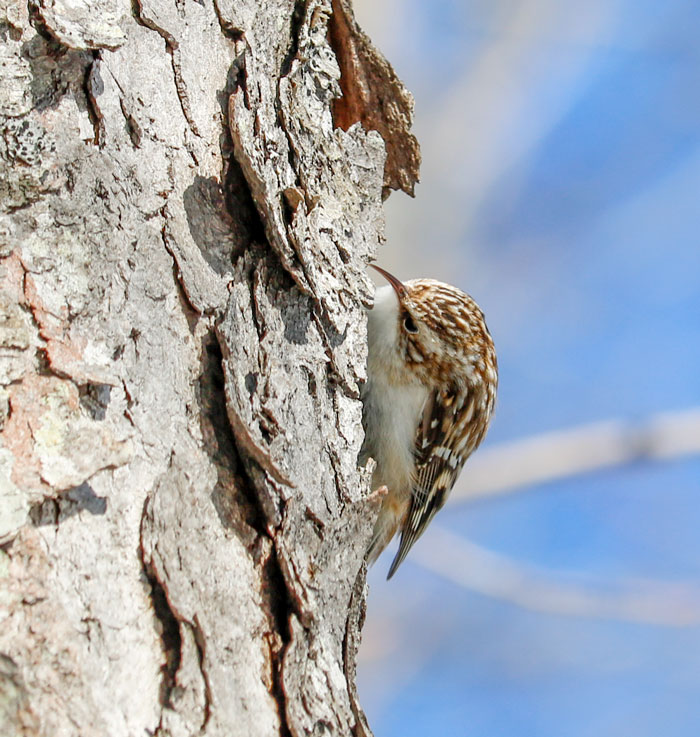
Thank you for reading and I hope you enjoyed learning about these intriguing little birds. Remember, the next time you are in the woods and you dismiss what you glimpse out of the corner of your eye, you may want to stop and take a closer look. You just may discover the unexpected and delightful brown creeper, too.
Resources used for this post:
allaboutbirds.org & audubon.org
Leave a Reply